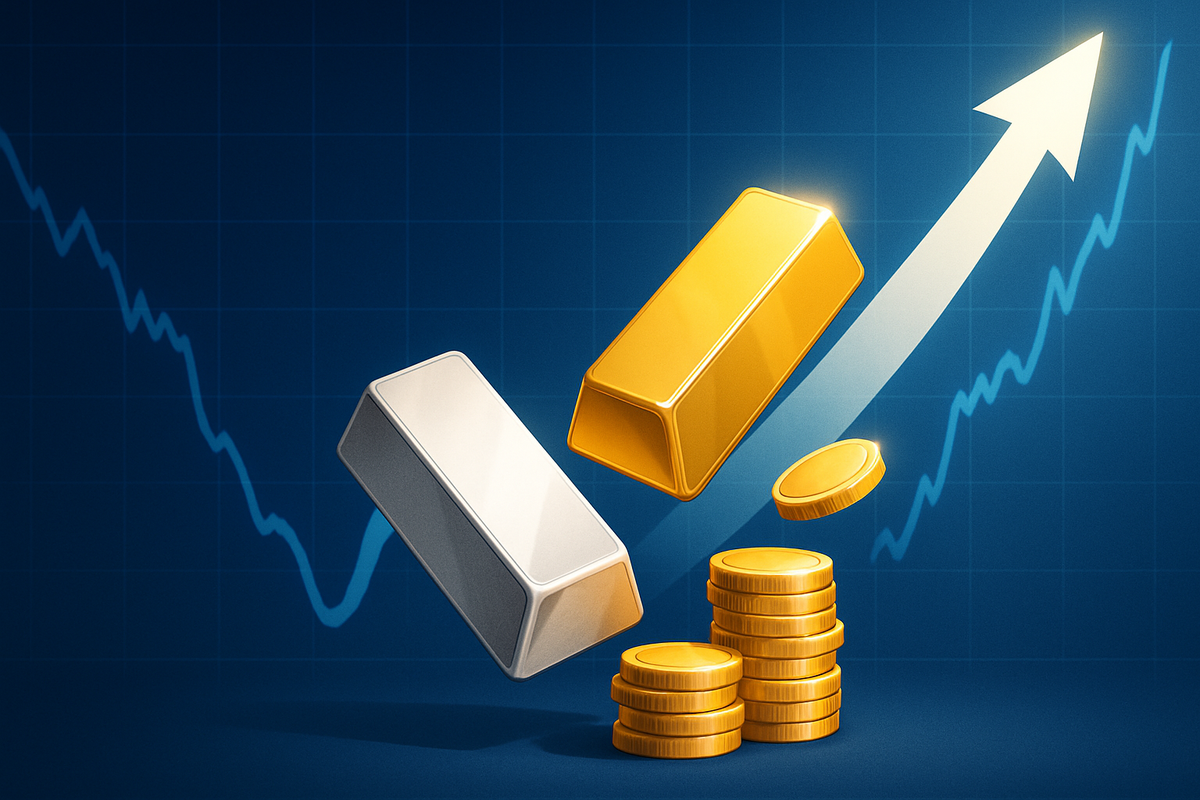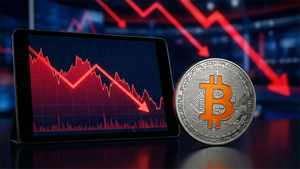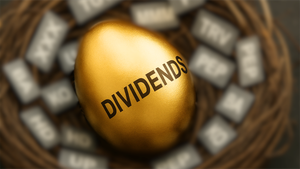Financial News
Gold and Silver Stage Resilient Rebound as Value Buyers Emerge After Steep Sell-Off

Gold and silver futures have staged a remarkable comeback, demonstrating robust resilience after a sharp, volatile sell-off that gripped the markets between October 20 and October 23, 2025. This significant rebound, primarily fueled by aggressive "value buying," has shifted investor sentiment, transforming what initially appeared to be a significant correction into a potential "buy the dip" opportunity. The precious metals market, currently in flux, is navigating a complex interplay of underlying bullish sentiment, profit-taking pressures, and evolving global economic narratives, with implications for diversified portfolios and broader market stability.
Detailed Coverage: From Record Highs to Swift Corrections and Resilient Recovery
The precipitous decline in gold and silver futures followed a period of unprecedented gains. Gold futures (COMEX: GC=F) had surged over 60% since the start of 2025, peaking at approximately $4,398 per ounce on Monday, October 20. Silver futures (COMEX: SI=F) witnessed an even more dramatic ascent, with roughly 90% year-to-date gains, reaching a record high of $54.3775 per ounce in mid-October. This meteoric rise set the stage for a sharp correction driven by aggressive profit-booking and a confluence of macroeconomic factors.
The sell-off was swift and severe. On Tuesday, October 21, Comex gold futures experienced their largest single-day percentage drop since September 2011, plummeting over $250 (5.74%) from their record highs, with spot gold falling as low as $4,090.97 per ounce. Domestically, MCX gold futures (MCX: GOLDM) plunged by Rs 6,414 (5%) to close at Rs 1,21,857 per 10 grams. Silver futures (MCX: SILVERM) also bore the brunt, dropping by Rs 4,769 (3.17%) on the MCX and over 7% in New York. This correction was primarily attributed to widespread profit-taking after deeply overbought conditions, a strengthening US Dollar, fading safe-haven demand amidst easing US-China tensions, and reduced physical demand post-Diwali in India.
However, the tide turned dramatically on Thursday, October 23, 2025. Aggressive "value buying" emerged as traders capitalized on the significantly lower price points. This renewed interest, coupled with improving global risk sentiment, propelled both metals upwards. MCX gold futures for December delivery surged by Rs 1,800 (1.48%) to Rs 1,23,657 per 10 grams, while global Comex gold futures for December delivery rose by USD 73.44 (1.81%) to USD 4,138.84 per ounce. Silver futures mirrored this strength, with MCX silver futures climbing Rs 2,727 (1.87%) to Rs 1,48,285 per kilogram, and international silver futures gaining 0.89% to USD 48.10 per ounce.
The initial market reaction to the sell-off was one of caution and uncertainty, with many questioning the sustainability of the earlier rally. However, the rapid rebound has instilled a sense of cautious optimism, suggesting that the correction might have been a healthy recalibration rather than a fundamental shift in the bullish outlook. Key players in this dynamic include institutional investors, hedge funds, and retail traders, whose collective actions in both selling and buying fueled the volatility. The US Dollar's performance and upcoming economic data, particularly the US Consumer Price Index (CPI), are now under intense scrutiny, as they will significantly influence near-term price movements and investor sentiment.
Company Fortunes Shift: Winners and Losers in the Precious Metals Rebound
The resurgence in gold and silver futures has created a clear bifurcation in the market, with direct beneficiaries in the precious metals sector poised for significant gains, while other industries grappling with increased raw material costs may face headwinds. This shift in commodity prices directly impacts stock performance, profitability, and strategic operational decisions for a range of public companies.
Gold and silver mining companies stand as the most immediate and substantial winners. A rise in metal prices directly inflates their revenues and expands profit margins, assuming production costs remain relatively stable. Major gold producers like Newmont Corporation (NYSE: NEM), Barrick Gold Corporation (NYSE: GOLD), and Agnico Eagle Mines Limited (NYSE: AEM) are seeing their share prices rally, reflecting the enhanced value of their reserves and output. Similarly, silver-focused miners such as Pan American Silver Corp. (NASDAQ: PAAS), First Majestic Silver Corp. (NYSE: AG), and Hecla Mining Company (NYSE: HL) are experiencing a significant uplift, as their core business directly benefits from higher silver prices. Junior mining companies, with their inherent operational leverage, are often even more sensitive to these price swings, potentially yielding outsized percentage gains.
Beyond the miners, streaming and royalty companies like Wheaton Precious Metals Corp. (NYSE: WPM) and Franco-Nevada Corporation (NYSE: FNV) are also significant beneficiaries. These firms provide upfront capital to miners in exchange for future metal production at a pre-determined, often low, price or a percentage of revenue. They gain from rising commodity prices without bearing the direct operational risks and expenses associated with mining, offering a more de-risked exposure to the precious metals rally. Exchange-Traded Funds (ETFs) that track physical gold or silver, such as SPDR Gold Shares (NYSEARCA: GLD) and iShares Silver Trust (NYSEARCA: SLV), or those investing in mining equities like the VanEck Gold Miners ETF (NYSEARCA: GDX), are also seeing their net asset values and share prices appreciate in direct correlation with the metals' rebound.
Conversely, industries heavily reliant on gold and silver as raw materials are confronting rising production costs. Manufacturers in electronics, solar panels, electric vehicles, medical equipment, and jewelry sectors are particularly vulnerable. For instance, Japanese electronics giants like Murata and TDK, which utilize silver in their components, have previously faced pressures from surging silver prices, potentially leading to increased product costs or squeezed margins. Smaller technology firms or niche manufacturers might find these elevated input costs directly impacting their competitiveness and overall viability. Companies that had hedged their precious metal exposure at lower prices may also miss out on the full benefits of the rally, as exemplified by past instances where hedging strategies proved suboptimal in a rapidly rising market. High-cost producers within the mining sector, with less efficient operations or higher all-in sustaining costs (AISC), might also find their profit margins less dramatically improved compared to their more efficient counterparts, even amidst a general price increase.
Broader Implications: A Barometer of Global Uncertainty
The rebound in gold and silver futures is more than just a short-term market correction; it serves as a potent barometer of broader industry trends and the prevailing global financial landscape. This event underscores the enduring role of precious metals as critical assets in an era marked by persistent economic uncertainties, geopolitical shifts, and evolving monetary policies, triggering significant ripple effects across various market participants and potentially influencing regulatory considerations.
This rebound aligns with several overarching industry and economic trends. Firstly, gold and silver continue to function as traditional hedges against inflation and currency debasement. With inflation rates stubbornly remaining above central bank targets, investors are increasingly allocating capital to precious metals to preserve purchasing power. Historically, gold has consistently appreciated during inflationary periods, such as the 1970s, delivering positive real returns. Secondly, escalating geopolitical tensions—from ongoing conflicts to trade disputes—coupled with economic uncertainties like potential government shutdowns, fuel a "flight to safety," bolstering demand for these safe-haven assets. Central bank accumulation of gold, exceeding 1,000 metric tons in both 2023 and 2024, further signals de-dollarization efforts and a strategic diversification of reserve portfolios, solidifying gold's long-term demand.
The dynamics of interest rates also play a crucial role. Lower interest rates reduce the opportunity cost of holding non-yielding assets like gold and silver, making them more attractive. Expectations of central bank policy shifts towards accommodation, particularly anticipated rate-cutting cycles, provide significant underlying support for precious metals prices. Furthermore, silver's dual role as both a monetary and an industrial metal is increasingly important. Robust industrial demand, especially from green technologies like solar panels, 5G infrastructure, and electric vehicles, contributes significantly to silver's price momentum. Persistent supply deficits in the silver market since 2021 create a favorable structural imbalance for higher prices, reinforcing its long-term bullish outlook.
The ripple effects extend beyond direct market participants. While mining and streaming companies benefit, industries relying on silver as a key input, such as electronics manufacturing and solar panel production, could face increased production costs, potentially squeezing profit margins if these costs cannot be passed on to consumers. Investment firms and ETF providers managing precious metals funds like SPDR Gold Shares (NYSEARCA: GLD) and iShares Silver Trust (NYSEARCA: SLV) see increased investor interest and inflows, boosting their assets under management and profitability. From a regulatory standpoint, significant market volatility often draws the attention of financial regulators, potentially leading to increased scrutiny over trading practices and market transparency. Moreover, central bank monetary policies, tariffs on imports, environmental regulations in mining, and the classification of silver as a critical mineral by governments (such as the U.S.) can all influence market dynamics and future investment.
Historically, the current rebound echoes similar patterns seen during periods of economic uncertainty and high inflation. The 1970s inflation crisis saw gold soar over 1,300% and silver over 1,500%, demonstrating their protective power. While the 1980 gold crash, driven by aggressive interest rate hikes, serves as a cautionary tale of the inverse relationship with rising rates, the April 2013 gold crash highlighted how sharp corrections can occur within broader bull markets, often presenting strategic buying opportunities for those who can withstand the volatility. These historical precedents underscore that while precious metals can offer stability and growth, they are not immune to sharp corrections driven by shifts in monetary policy or market sentiment.
The Road Ahead: Navigating Volatility and Opportunities
The recent rebound in gold and silver futures, while signaling renewed investor confidence, also ushers in a period of continued volatility and strategic repositioning for market participants. Both short-term fluctuations and long-term trends will be shaped by a complex interplay of economic data, central bank policies, and geopolitical developments, presenting both opportunities and challenges for investors and companies alike.
In the short term, the precious metals market is expected to remain a "gunslinger" arena, characterized by extreme daily price movements. Upcoming economic releases, particularly the US Consumer Price Index (CPI) data and Federal Reserve interest rate decisions, will be pivotal. While expectations of further rate cuts by the Federal Reserve by year-end could provide support, persistent core inflation or stronger-than-expected employment gains might lead to higher interest rates, exerting downward pressure on prices. Geopolitical events will continue to dictate safe-haven demand; any de-escalation of conflicts or improvement in US-China relations could temper buying, while new uncertainties would likely trigger renewed interest. Technical analysis suggests that gold might consolidate before its next major upward move, with potential short-term fluctuations, while silver, known for its higher volatility, could see sharper corrections within a broader bullish trend.
Looking further ahead, the long-term outlook for gold and silver generally remains robustly bullish, underpinned by several structural market dynamics. Persistent global inflationary pressures and continued record-level gold purchases by central banks, especially in emerging markets diversifying away from traditional currencies, are significant long-term drivers. For silver, its dual role as a precious metal and an industrial commodity provides strong support, with demand from green energy technologies (photovoltaics, electronics, electric vehicles) creating persistent supply deficits. Expectations of looser monetary policies in 2025 could decrease the opportunity cost of holding non-yielding assets, further enhancing their appeal. Long-term price targets, ranging from $5,000 to $10,000 per ounce for gold and potentially $100 to $200 or higher for silver by 2030-2035, underscore this optimism.
For investors, strategic adaptations are crucial. Given the heightened volatility, robust risk management is paramount, especially in futures trading with its inherent leverage. Diversification and a long-term accumulation strategy, focusing on gradual buying during price dips, are advisable. Utilizing the gold-silver ratio can help optimize allocations, suggesting buying silver when it's undervalued relative to gold. Beyond direct futures, investors can consider ETFs, options, and pooled accounts for exposure. Companies, particularly miners, should focus on cost efficiency and exploration to capitalize on higher prices, while industrial users of silver should consider hedging strategies using futures contracts to lock in future prices and manage material costs. All entities dealing with precious metals must implement robust risk management frameworks and maintain agile operations to adapt to rapid market shifts.
Market opportunities include sustained industrial demand for silver driven by the green energy transition, continued safe-haven inflows amidst geopolitical instability, and central bank diversification efforts. Some analysts believe precious metals are "under-owned" in portfolios, suggesting significant room for renewed investor interest. However, challenges persist, including extreme price volatility, potential profit-taking pressures after strong rallies, and the impact of a strong US Dollar. Speculative overhang in silver and potential liquidity issues in paper markets also pose risks. Potential scenarios range from a continued bull market with healthy corrections, driven by inflation and geopolitical tensions, to an aggressive bull market in a stagflationary environment. Conversely, a significant de-escalation of global conflicts or a decisive shift towards aggressive monetary tightening could lead to short-term weakness, though likely viewed as a buying opportunity in the longer-term bullish trend.
Conclusion: A Resilient Market Poised for Continued Significance
The recent rebound in gold and silver futures, following a sharp but ultimately temporary sell-off, serves as a powerful testament to the enduring significance of precious metals in a dynamic and often uncertain global financial landscape. This event, driven by a confluence of monetary policy expectations, persistent inflation concerns, and geopolitical tensions, has not only reaffirmed their role as critical safe-haven assets but also highlighted their potential for continued appreciation.
The key takeaways from this period of volatility are clear: gold and silver's initial surge to record highs was fueled by aggressive Federal Reserve rate cut expectations, persistent inflation, escalating geopolitical instability, and robust central bank demand. Silver, in particular, benefited from its dual role, with strong industrial demand bolstering its price. While a subsequent profit-taking correction was sharp, the rapid rebound, propelled by aggressive value buying, indicates that underlying bullish sentiment remains firmly in place. This suggests that many market participants viewed the dip as a strategic buying opportunity rather than a fundamental shift in the long-term outlook.
Moving forward, the market for precious metals is largely assessed as bullish, with experts forecasting continued strength into 2026 and beyond. Long-term price targets, ranging from $5,000 to $10,000 per ounce for gold and potentially $100 to $200 or higher for silver by 2030-2035, underscore this optimism. These projections are rooted in the expectation of sustained dovish central bank policies, persistent inflationary pressures, ongoing geopolitical volatility, and resilient industrial demand for silver. While short-term volatility and periods of consolidation are natural, they are largely seen as healthy pauses within a broader, long-term bull market.
The lasting impact of this performance extends beyond mere price movements. It signifies an eroding confidence in fiat currencies, prompting portfolio rebalancing towards higher allocations in gold. The rebound has unequivocally reinforced gold and silver's historical status as critical hedges against inflation, currency devaluation, and economic or geopolitical turmoil. Furthermore, the record central bank gold purchases underscore a broader trend towards de-dollarization, hinting at a shift in the global financial architecture. For investors in the coming months, a strategic approach is vital: embrace diversification, closely monitor Federal Reserve policy and inflation data, stay attuned to geopolitical developments, and consider value buying on dips. Understanding silver's dual nature—its monetary and industrial demand—is also crucial. Ultimately, while market fluctuations will persist, the fundamental case for precious metals as a store of value and portfolio diversifier remains compelling, suggesting a robust outlook for the foreseeable future.
This content is intended for informational purposes only and is not financial advice
More News
View More




Recent Quotes
View MoreQuotes delayed at least 20 minutes.
By accessing this page, you agree to the Privacy Policy and Terms Of Service.



